Here is a piece that just came in. It’s for a piece of furniture that a local company is refinishing. They send me pieces from time to time that need repair, duplication or in this case just splice in some wood and complete the carving. I originally wanted to re-carve the pieces but they felt they would have no problem matching the stain and having the repair disappear. Besides , it saved them some money I don’t think they budgeted for.
The photos and brief description tell the story.
Here are the two pieces in need of repair. The overall piece is approx. 11″ X 3 1/2″ X 1/4 inch. As you can see the bottom of the pieces have been knocked off. I started by making a pattern using the top edge of the piece for reference. As these are mirror images the one pattern worked for both. I simply placed a piece of card stock under the carving lining it up with the top edge for reference and just drew what I thought the missing piece looked like.
 Once I had my pattern I then went to the table saw and cut away the remaining damaged sections on each piece getting back to solid wood where there was no damage. One would pass into the saw with no problem using the top edge as a guide. The other had to be placed over the saw with the blade down and then gradually brought up to cut through the piece as the top edge and location of the broken piece wouldn’t allow me to make a conventional pass through the saw. Then a simple matter of completing the cut using my band saw.
Once I had my pattern I then went to the table saw and cut away the remaining damaged sections on each piece getting back to solid wood where there was no damage. One would pass into the saw with no problem using the top edge as a guide. The other had to be placed over the saw with the blade down and then gradually brought up to cut through the piece as the top edge and location of the broken piece wouldn’t allow me to make a conventional pass through the saw. Then a simple matter of completing the cut using my band saw.
 Once the cut was made I used my pattern to determine just how big , and what shape the repair piece needed to be. I cut the repair piece out of a matching ( grain wise) mahogany that was cut to the thickest dimension of the applique. Once the piece fit perfectly I glued and clamped it into position. The sections I glued in were approx. 3 1/2 ” long, and one was 2 1/4″ and the other 3 1/4″ wide
Once the cut was made I used my pattern to determine just how big , and what shape the repair piece needed to be. I cut the repair piece out of a matching ( grain wise) mahogany that was cut to the thickest dimension of the applique. Once the piece fit perfectly I glued and clamped it into position. The sections I glued in were approx. 3 1/2 ” long, and one was 2 1/4″ and the other 3 1/4″ wide
Here is the right side piece with the new wood glued in place. I then drew the design on the wood and followed with my router on this piece to remove the deepest part of the design to match the depth of the rest of the carving. Then with my chisels carved the rest of the design following the contours of the original. Pretty simple as carving goes as it was primarily bevels . Then a quick sand with some 220 blended it perfectly with the original piece.
The resulting carving on the new section matches just fine with the old section. I always have to restrain myself doing pieces like this as I’d do the accent lines differently but in cases like this I have to remember to try and match the “hand” of the original carver and the style of their carving.
 The left side didn’t require me to use the router as the splice didn’t extend into the deeper area of the carving. This, with the Mahogany , was a few quick passes with a #2 wide chisel to essentially complete what was needed in the way of carving. The small area inside the curve was a #5 to create a bit of a curve then finish it off with a few passes of the #15 to complete the small lines. Generally before doing the small lines such as the ones here, you have to sand the piece to it’s final shape and then add the lines. Otherwise you’ll just sand away some of the crispness of the lines and have to do them over.
The left side didn’t require me to use the router as the splice didn’t extend into the deeper area of the carving. This, with the Mahogany , was a few quick passes with a #2 wide chisel to essentially complete what was needed in the way of carving. The small area inside the curve was a #5 to create a bit of a curve then finish it off with a few passes of the #15 to complete the small lines. Generally before doing the small lines such as the ones here, you have to sand the piece to it’s final shape and then add the lines. Otherwise you’ll just sand away some of the crispness of the lines and have to do them over.
Well that’s the job. Now call the client and have them pick them up. Hope you found something useful here. Things like this are a welcome break from the norm, are fun and a bit interesting to do, and it still adds something to the cash flow.
Thanks,
Mark




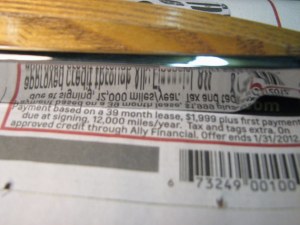






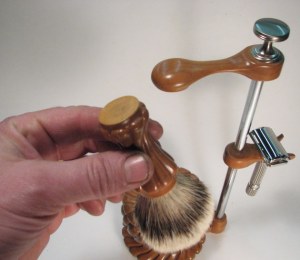
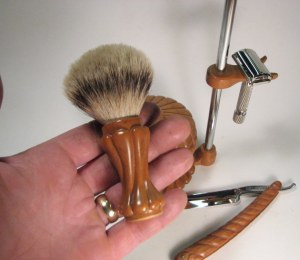
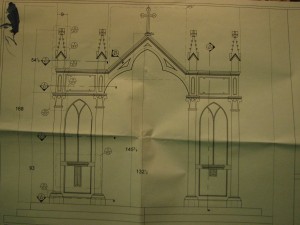
















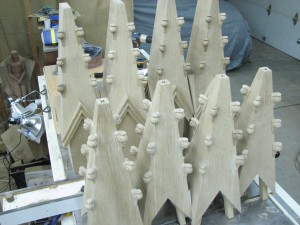




recent comments